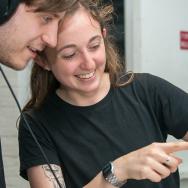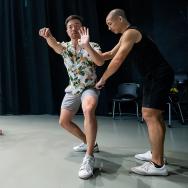Fermilab is America’s particle physics and accelerator laboratory.
So, you might be surprised to discover what exists on the second floor of Wilson Hall on the University of Chicago-affiliated lab’s 6,800-acre campus in Batavia, Illinois: a formal art gallery.
The Fermilab Gallery serves as the site of the annual culmination of the laboratory’s artist-in-residence program, now in its seventh year. Mark Hirsch, who uses computer models and coding for his art, was recently selected as the 2021-22 artist-in-residence, joining guest composer David Biedenbender, who plans to explore questions such as: What might particles colliding sound like?
The connection between art and science has always been part of Fermilab’s framework, instilled by its founding director, the late physicist-artist-sculptor-writer Robert R. Wilson. The creation of Fermilab’s artist-in-residence program in 2014 then, only made sense to help increase the public understanding of its scientist’s work.
“Over the years, people are realizing the strength of this connection between art and science,” said Georgia Schwender, Fermilab’s art gallery coordinator and founder of the artist-in-residence program. “With this public outreach, we are trying to answer the question of, how do you get people who might not be interested in particle physics at the equation level interested in just learning about it?
“Visually, this is a way to get them in.”
The annual call for artists is open to visual artists, composers, choreographers, and writers. Over the last seven years, Fermilab has had a mix of artists using different mediums, from UChicago alum and photographer Adam Nadel, AB’90, to sculptor Jim Jenkins, to digital artist Ellen Sandor, to name a few. Each selected artist then interacts with various scientists at the laboratory, learns more about experiments and research, and spends the year creating artwork based on what they learn.
The goal is to have the artists serve as ambassadors to the arts community, inviting them to look at the science of particle physics from a new, more resonant perspective.
Nadel, the 2018 artist-in-residence, used Fermilab’s high-energy electron beam to make “Nadelgrams,” a nod to Man Ray’s cameraless rayographs. Nadel’s negative space images were created after the beam—the Accelerator Application Development and Demonstration (A2D2) tool—was aimed precisely at photographic paper, using electrons instead of light to capture the invisible world.
“Artists and scientists are both really creative and they have fabulous imaginations,” said Schwender, who has worked at Fermilab since 2001. “They are both very different but also very similar—almost like the other side of the coin, you know? I think we are really finding that common ground between artists and scientist and building upon both their strengths, in addition to also being able to communicate that to our community.”
The guest composer component was added a year ago in response to the “many fabulous musicians” who have applied over the years, only furthering the evolution of a program that Schwender compared to a snowball going downhill: “It just keeps getting bigger and better,” she said.
The diversity of the artwork and artists, the excitement by the scientists to have others understand their research, and the public’s increasing appetite for the program have all aided in its growth. Over the last year, the reach of Fermilab’s artists-in-residence also expanded—due to the closure of Fermilab to the public because of the COVID-19 pandemic—with lectures and talks moved to the virtual space, which allowed even more people to join the conversation.
“Our audience has grown so much because of it being virtual, so I think we will have to look to create hybrid (in-person and virtual) artist talks in the future—it’s a global thing now,” Schwender said.
The 2020 guest composer, David Ibbett, is also working on an album of neutrino-themed music, several songs which have already been released.
You can learn more about Fermilab’s artist-in-residence program on its website, which includes a full archive of all of its past artists, recordings of previous artists’ lectures (like one from 2020 artists-in-residence Chris Klapper and Patrick Gallagher), and upcoming events.
Fermilab is managed by Fermi Research Alliance, LLC, a partnership of the University of Chicago and Universities Research Association. The lab is not yet open to the public. Check Fermilab’s official website for updates.

